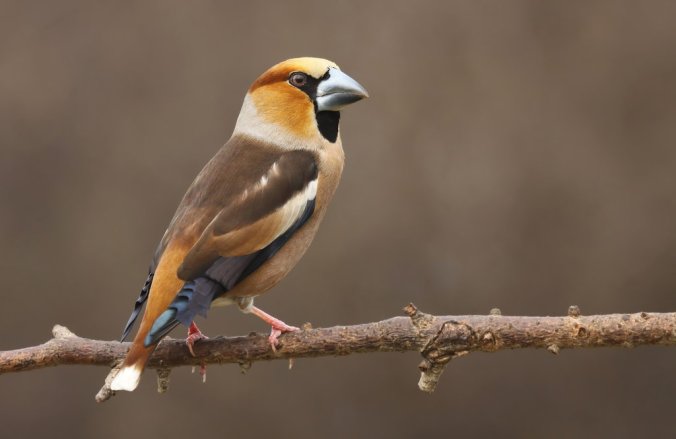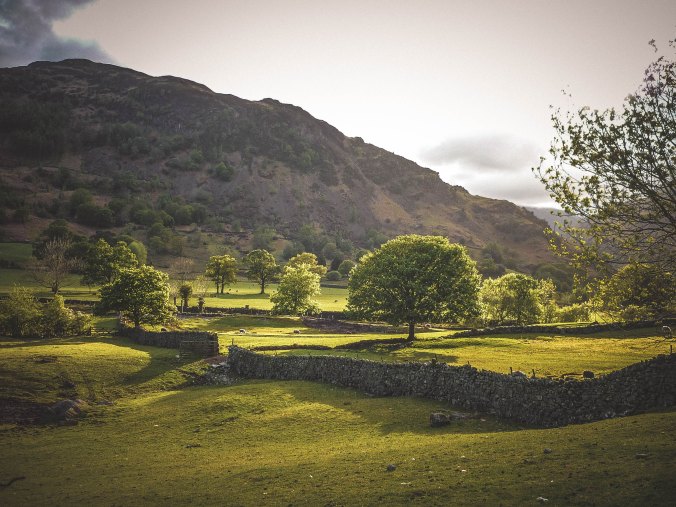For many people finches are a common sight on their bird tables, from the geometrically patterned goldfinch to the tamer coloured greenfinch or the pinky chaffinch. Yet not all finch species are so easily spotted, indeed one UK species is notoriously difficult to observe; the hawfinch. See any photo of this charismatic bird and you’ll be amazed that you ever missed it. Big and chunky with a large powerful beak, the male wears beautiful peach and orange colours with a bluish beak and a dark line about it’s eyes. They look altogether parrot-like and exotic.

The hawfinch is found throughout much of Europe, with Germany, Romania and Croatia being particular strongholds. It is also widespread throughout Eastern Asia and northern Africa. In the UK it’s only a relatively recent resident, the first breeding records appearing in the early 19th century. In time this colony spread from its home in south east England up towards the Midlands and today breeding colonies are observed in Wales, Cumbria and even into Scotland. Yet the hawfinch’s temporary success seems destined not to last, with numbers crashing over the last few decades, some populations disappearing entirely, such as one found in the New Forest. Today the Royal Society for the Protection of Birds (RSPB) quotes the breeding population at 1,000 pairs and the winter population to reach up to 15,000 individuals. Decline in these wonderful birds could be down to a number of reasons but the main one is believed to be a reduction in the birds favourite foods, in particular trees bearing tasty fruits or nuts.

Winter is the best time to spot hawfinches, not just because their numbers swell significantly in the UK, but also because these birds spend much of their times high in the canopy, making them almost impossible to spot once trees are in leaf. Their favourite foods are cherry pips and hornbeam seeds but they’ll munch on all kinds of forest fruits and nuts across the year, taking advantage of what’s available across the season. Their big powerful beaks are perfectly designed for crackng open the hard shells, so much so that their Latin name actually means ‘seed breaker’ (cocothraustes).
The winter of 2017/18 brought exceptional numbers of hawfinches to the UK, with large flocks occupying some of the southern counties and the rest despersed across the country. Why this might be after years of decline no one is really sure, but the unusual chill covering much of Europe may have forced these little birds further afield looking for food and warmth. Birders were delighted, with these wonderful birds popping up in local parks, gardens and even agricultural fields. Yet somehow the winter of hawfinches seemed to be passing me by with not a bird in sight, so we decided to go for all or nothing.

Sizergh castle is a medieval mansion looked after by the National Trust, with a wonderful formal garden and expansive parkland on the edge of the Lake District near Kendal. Wonderful as the house and the grounds were we had one clear objective when visiting the site; to see hawfinches. Sizergh is a famous spot for hawfinch spotting, with hawfinch watching events run every weekend from March till May, the best time to spot these birds as they spend more time foraging on the ground for fallen seeds and nuts.

Unglamorous as it may seem the best place to spot our finches is in fact the car park, due to a collection of hornbeams growing here and the openness of the canopy and ground flora meaning the birds are less obscured. As with most wildlife the best time was early morning with the hawfinch watch taking place from 8am until 10am. After this time the birds are often scared off by the many visitors and their dogs.

So we rose early and donned our thermals and binoculars, reminding ourselves sensibly that nature doesn’t always play ball and our journey might end hawfinch free. The day didn’t look promising as we left our holiday cottage, cold and drizzly, but as we drove along the quiet country roads, beautiful hills and rolling farmlands surrounding us, the sky began to lighten and the rain ease.
There were already several people standing on the cafe veranda, overlooking the car park, as we arrived. A true birder had been on patrol since early morning and had spotted two hawfinches at 7am. For now we simply had to watch and wait.
A line of black sunflower seeds had been scattered on the far side of the car park to attract in birds. As we watched chaffinches, blue tits and housesparrows all bobbed in and out of view, getting their fill. The two most exciting visitors were the bullfinches and nuthatches. The bullfinches came down in pairs of two, the males with their bulbous red bellies and the more demure females hopping at their side. The nuthatches also came in a pair, with the male (I presume, as both sexes look the same) sitting in a low tree barely a meter away from us and singing out his morning challenge to any other males in the area. Soon after he alighted on the banister of the veranda looking questioningly at the crowd as if to check we weren’t after his lady.
With all this, and a walk through the castle grounds after, I would have been fairly happy with our visit, but the crowning glory soon came. A hawfinch swooped into shot, taking up residence in the top branches of a nearby tree and beginning to sing his heart out. Now the hawfinch song is rather less spectacular than its look. A simple click is all you’ll hear, quiet and occasional and easily missed amongst the louder calls of the robin, the wren and the blackbirds. But sat so close and calling so clearly we were able to pick out his song.
Two hawfinches made their appearance in the end, perching up above the trees or bobbing along with the other birds below. It was a wonderful sight. It may not seem important to go out of your way to see the rarest birds or most unusual wildlife, and it isn’t really. If you can enjoy the robin in your garden and the songthrush calling from the hedgerows then you really don’t need to drive halfway across the country looking for a hawfinch. But sometimes it’s nice to see and admire these species living on the edge, to know even better why it would be a shame to lose them and why we should work harder to save them.